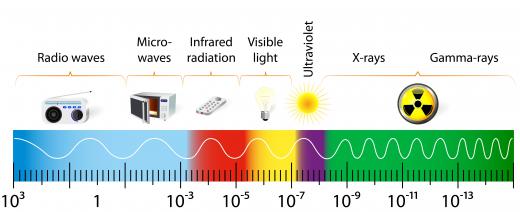What is a Frequency Spectrum?
A frequency spectrum is a scientific method of plotting and classifying electromagnetic waves as they occur in space and in the everyday environment. Actually calculating the frequency of various transmissions can be a complex science and usually involves intensive formulas and measuring equipment. As a concept, though, the spectrum itself is relatively straightforward. Anything that gives off energy does so at a particular frequency. Light, sound, television, and radio transmissions are some of the most common; X-rays, microwaves, and infrared signals are also included. The frequency spectrum is how these and other emissions are plotted and classified, and the discrete and unique elements of each are usually represented by the amount of radiated energy each produces per second.
Understanding Frequency Generally

Frequency is broadly defined as the number of complete electromagnetic energy wave cycles that occur each second. The international unit of measurement used to describe one cycle is 1 hertz (Hz). Since each portion of the electromagnetic spectrum has a telltale frequency signature, it can be identified by means of a spectrum analyzer that is capable of accurately measuring the wave cycles per second of the particular electromagnetic phenomenon under observation.

These numbers are really important for a couple of different reasons. Physicists often spend a lot of time plotting the spectrum of different frequencies in order to understand how these waves interact with matter, as well as to determine things like the outermost limits for sound and light waves. They’re also important for health reasons; researchers need to know what levels of things like X-ray and microwave technology are safe for use in homes and medical offices. In broadcasting, the spectrum identifies which frequencies are the most populated, and thus the most prone to interference and broadcast difficulties.
Plotting Electromagnetic Energy
Each of the varied forms of electromagnetic energy occupies a designated place on the spectrum. The electromagnetic continuum, as expressed in terms of the frequency or the intensity of radiation emitted by each distinct segment, ranges from 106 Hz up to 1025 Hz. Radio waves occupy the low end of the spectrum whereas radioactive gamma rays occupy the high end. The frequency range encompassed by the electromagnetic spectrum is immense. Frequencies generated by radio transmissions and those produced by visible light vary by an order of magnitude of a million billion.
Light and Sound
When it comes to both light and sound, the levels of the frequencies emitted is in large part responsible for how humans perceive the color or sound being transmitted. In order for light to appear as a distinct color, it must emit energy within the electromagnetic range associated with that color. One of the easiest ways to demonstrate this is with a prism or other beveled crystal. In the sunlight, the solar energy is transmitted differently through the different refractions, with the result that different colors appear to be shining out. In truth the light is the same no matter how it looks, but the refraction changes the electromagnetic energy, leading to color.
Sound waves work similarly. Different musical notes can harness different energies, which can make them appear to have different qualities to those who are within listening range. Artists often harness this to make acoustical compilations more interesting. The intentional mixing of sounds across the spectrum is often known as “white noise,” a technique sometimes employed to promote better sleep.
Special Considerations for Broadcasters
The frequency spectrum for radio, television, and other broadcast transmissions is further classified into ranges of frequencies or "bands," both as a means for minimizing interference as well as for sharing bandwidth among multiple users. Most of these are regulated by various authorities. The International Telecommunications Union Agreement, for instance, allocates certain ranges of radio transmission frequencies so as to minimize interference in the shortwave radio spectrum. The high frequency bands are allocated among international shortwave broadcasters, amateur radio operators, and marine radio communications.
In order to ensure reliable, interference-free radio transmissions, domestic governmental agencies often regulate certain aspects or parts of the spectrum. In the United States, the Federal Communications Commission (FCC) allocates the frequency bands between businesses, the general public, and amateur radio operators so as to limit any potential cross-band interference. Each band is designated a specific frequency range, and that frequency spectrum is reserved for each of the various user-specific groups.
AS FEATURED ON:
AS FEATURED ON:












Discussion Comments
The FCC also controls how much power a transmitter can use so as to prevent interference. For example, let's say you've got a station in Conway, Ark., transmitting on 93.1 FM. Another channel in Memphis is also transmitting on that channel. The FCC can limit how much power, or watts, one or both stations can use so as to not interfere with the audiences of the respective stations.
The same regulations were in place for CB radios in the 1970s -- there was a popular technology with the potential to create all sorts of interference in the somewhat narrow frequency spectrum shared by a lot of users.
What a lot of computer users may not realize is that Wi-Fi -- the nifty invention that allow for wireless connectivity to the Internet through a router -- is heavily dependent on the frequency spectrum.
Why is that important? Wi-Fi users can experience interference just the same as radio stations that are using the same radio band (just listen to the signals competing on an AM radio band to get an idea of what a problem interference can be). If you find that your Wi-Fi signal is getting dropped by your router frequently, the problem may be that there are other routers in your area communicating on the same channel.
There are open source programs that will let you see which channels are being used in your area. If you suspect interference is a problem, run one of those those and pick a channel that is less crowded.
Post your comments